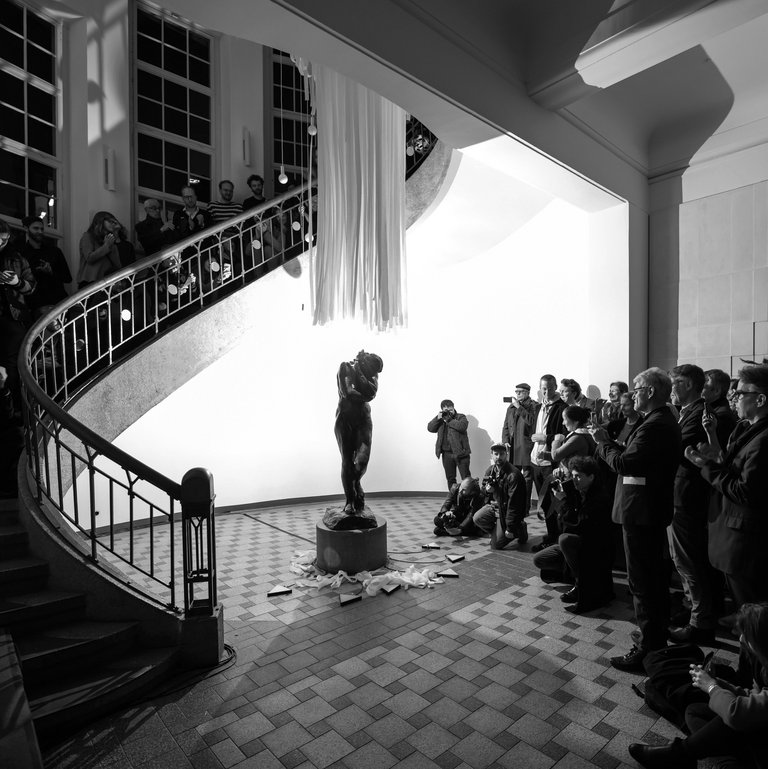Following the deliberate vandalisation of the statue in February 2016 and its successful restoration in the workshop of Ilja Streit, »Eva« was welcomed back to her original position in the Main Building of the Bauhaus-Universität Weimar during an official ceremony. The event was attended by countless visitors from the University as well as local Weimar residents. Music and light installations accompanied the official unveiling of »Eva« in the Main Building. Prof. Dr. Winfried Speitkamp, President of the Bauhaus-Universität Weimar, opened the event with the words: »This is a special moment for our University.« He continued: »The act of violence and intentional vandalisation committed in 2016 yielded great solidarity and support. I would therefore like to express my sincere thanks to all those who have been involved in the restoration, and of course particularly those who made the restoration possible with their donations. Our special thanks to Thomas and Birgit Rabe, who made a considerable donation and contributed a large portion of the money needed for the restoration work.«
»›Eva‹ has actually always been here,« emphasised Prof. Bernd Rudolf, the Dean of the Faculty of Architecture and Urban Affairs, in his welcome address. »›Eva‹ is a constant, a trust-inspiring figure, and a good spirit for all visitors as well as for the students and staff of this University.« Rudolf also recalled the sculpture’s constant integration into university life at the Bauhaus-Universität Weimar: »Rodin’s ›Eva‹ has been the linchpin of countless events and will hopefully reprise this role for many years to come,« said Rudolf. In his speech, Dirk Slawinsky addressed »Eva« in familiar terms, welcoming her back as the University’s »oldest student« with her »212 semesters« of attendance. Speaking on behalf of the StuKo (Student Government), Slawinsky thanked all students at the Bauhaus-Universität Weimar for their support during the restoration work.
»Since the 1980s, she has constantly stood in her central location in the Main Building, marking the heartbeat of the University: admired, loved and the focus of many events,« said Dr. Christiane Wolf, Director of the Modernist Archive at the Bauhaus-Universität Weimar. In her presentation entitled »Eva gehört zu uns« [»Eva is a part of us«], Wolf not only took a look back at »Eva«’s eventful past, but also shared details of the restoration work that she supervised for two years, working closely with the team headed by the Weimar-based restorer Ilja Streit. »Stefanie Papenheim and Ilja Streit used state-of-the-art technology and 3D processes to successfully return our ›Eva‹ to exactly as we have always known her. I applaud this achievement,« Wolf said.
In his closing address, the renowned art historian and visual scientist Prof. Dr. Horst Bredekamp, who is a professor at the Humboldt-University zu Berlin, traced the bronze sculpture’s creation. He presented various perspectives on the effect and history of the work under the title of »Metamorphosen von Rodins Eva« [»The Metamorphoses of Rodin’s Eva«]. Bredekamp praised the determination with which the Bauhaus-Universität Weimar reacted to the incident. »The attack on ›Eva‹ is unfortunately just one of a whole series of attacks on works of art all around the world. Particularly controversial pieces are targeted by vandals time and time again. The great determination with which the Bauhaus-Universität Weimar turned the horror of this act into an immediate initiative to restore ›Eva‹ and to return her to her place as quickly as possible is thus all the more significant. The way in which the University reacted to this incident deserves respect and is encouraging,« said Bredekamp.
From Paris to Weimar: Rodin’s »Eva« through the ages
The bronze sculpture »Eva« is part of a major project by Rodin. In 1881, the French sculptor and draughtsman was commissioned to design a portal for the planned new Museum of Decorative Arts in Paris. The 4.50 metre high and 3.50 metre wide portal was to be flanked by figures of Adam and Eve on pedestals. Rodin worked on the portal almost continuously between 1880 and 1884. Many of Rodin’s most important works from the 1880s and 1890s originated from the so-called »Gates of Hell« – often in the form of an enlargement of a figure taken from the ensemble. The »Thinker«, »Adam« and »Eva« received unanimous recognition as entirely independent works.
In 1912, the University’s director at the time, Fritz Mackensen, had »Eva« erected in the Main Building of the Grand Ducal Vocational Arts School in Weimar as an expression of the free spirit of art. Mackensen acquired her from the Parisian artist’s workshop in 1911. He was able to convince Auguste Rodin to have another bronze cast made for Weimar. The foundation of a manufacturer from Apolda finally made it possible to acquire the nude, which was controversial at the time. For more than 103 years, »Eva« adorned the rooms of the Bauhaus-Universität Weimar undamaged, mostly in her current location in the foyer of the Main Building. In her long-standing location, »Eva« entered into an impressive interplay of form and light with the staircase of the Main Building designed by Henry van de Velde that was inaugurated back in 1911. This not only made this place an attraction for a great many tourists, but also somewhere that Weimar students and teachers were able to identify with over the decades.
However, the bronze statue’s central, freely accessible location in the foyer of the Bauhaus-Universität Weimar’s Main Building also proved its downfall when a hooligan deliberately knocked it from its plinth on 7 February 2016. The sculpture suffered considerable damage. Thanks to countless donations, the financing for the restoration work was secured at the end of 2017 and a team of restorers found to carry out the extensive restoration, conservation and security measures.
